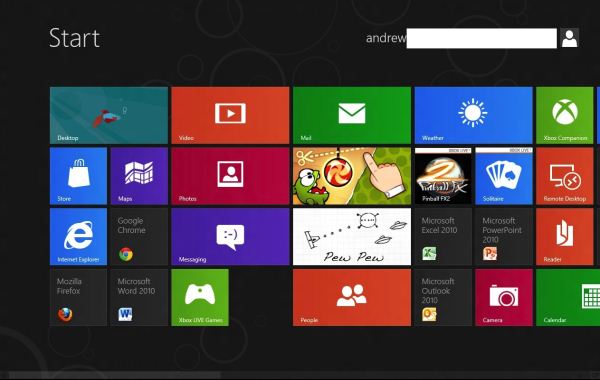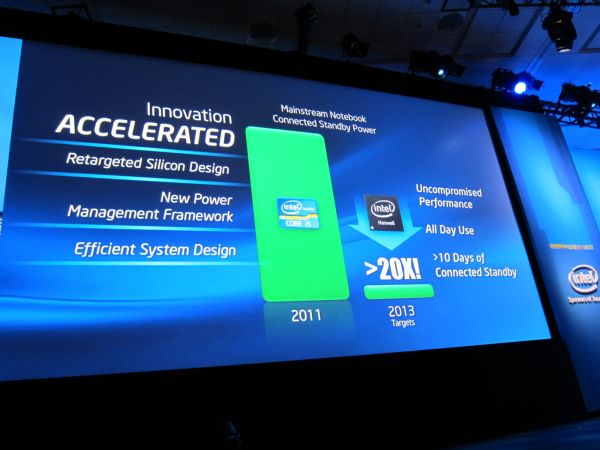The Apple iPad Review (2012)
by Vivek Gowri & Anand Lal Shimpi on March 28, 2012 3:14 PM ESTThe Next iPhone
Historically the iPad has been the launch vehicle for Apple's next-generation iPhone SoC. It's safe to say that the 45nm A5X we've seen here today won't be finding its way into a smartphone. Instead what we're likely to see in the next iPhone this year is a 28/32nm shrink of the A5, coupled with Qualcomm's 28nm MDM9615 instead of the 45nm MDM9600 enabling LTE support.
It'll be next year before we see the introduction of the A6 in the fourth generation iPad, which will likely bring ARM's Cortex A15 to the table as well as Imagination Technologies' PowerVR Series 6 (codename Rogue) GPU. Apple isn't done driving GPU performance. There's still a chance we'd see the introduction of a Cortex A15 based SoC late this year for the new iPhone but I still believe the timing is too aggressive for that to happen.
Haswell
In working on this review, Vivek IMed me and told me the best part of using an iPad instead of a notebook is the battery life. When the battery indicator reads only 20% left, chances are you've still got a good couple of hours of battery life left on the new iPad. On a MacBook Pro? You're lucky if you get half of that.
The question is, must this gap always exist? The MacBook Pro has much more power hungry silicon, and it's running a much more power hungry OS and application set. I won't go too far into this but one of the promises Intel is making with Haswell, its 2013 microprocessor architecture, is for a > 20x decrease in connected standby power. Intel's goal is to be able to deliver an Ultrabook in 2013 that can remain in connected standby (still receiving emails, Twitter updates, push notfications, etc...) for up to 10 days on a single charge.
What about for a lighter, more tablet like usage model? Will Haswell be able to deliver more iPad-like battery life for most tasks, but offer the horsepower and flexibility to run a traditional OS? I'm hearing very exciting things about next year...
Windows 8
A while ago I made a list of the top 10 things I did with my computer. It looked something like this:
Web Browsing
IM
Photo/Video Editing
Excel
Editing Reviews (HTML)
Publishing Reviews (FTP, CMS access)
3D Gaming
Writing
Email
Twitter
Of that list of 10, most of them could be done on a tablet, but only a couple of them delivered a better experience on a tablet than on a desktop/notebook (web browsing and email). You could argue that interacting with Twitter is also better on a tablet as well. Regardless of where you draw the line however, the fact of the matter is that for a user like me I can't replace a notebook with a tablet or vice versa. I need both. I don't like the idea of needing both, I'd rather just have one that could always deliver the best experience possible.

It's this problem I believe Microsoft is trying to address with Windows 8. Put Windows 8 on a convertible or dockable tablet (ala ASUS' Transformer Prime), with x86 hardware, and you've got a very real solution to this problem. When you want a touchscreen tablet, you've got one. When you want a more traditional workhorse notebook, you've got one there as well. I make the x86 reference because that way you don't lose out on compatibility with all of your older desktop apps that you may rely on.
For years Microsoft has failed to deliver a consumer friendly tablet by forcing a desktop UI on it. Its experience with Media Center taught us all that vastly different usage models need different user interfaces. It took Microsoft a long time to realize this, but with Windows 8 I believe it has one solution to the tablet problem. It is ironic/funny/depressing that with Windows 8 Microsoft is simply making the same mistake it made for years with tablets, in reverse. This time around the desktop experience suffers (or at best, just isn't moved forward) in order to focus more on the tablet experience. Sigh, one of these days they'll figure it out.
The point of this sidebar on Windows 8 is to talk about the iOS equivalent. Apple advocated so strongly with the iPhone for the consolidation of devices, I can't help but assume that we'll see a similar move in the MacBook Air/iPad space. iOS is far more multitasking friendly today than it was a couple of years ago. The support for multitasking gestures alone on the iPad is huge. But there clearly has to be more. I don't even know if iOS 6 is really when we'll see this intersection between tablet and ultra portable happen. Like Haswell, this may also be a 2013 thing...











234 Comments
View All Comments
PeteH - Wednesday, March 28, 2012 - link
No idea. Was it necessary to upgrade the GPU to get an equivalent experience on the larger screen in that case, or was performance on the 3GS limited by the CPU (or RAM, or something else)?zorxd - Thursday, March 29, 2012 - link
just look at benchmarks on this web siteThe iPhone 3GS gets more FPS in 3D games because of the lower resolution.
So in short, yes, it would have been necessary to upgrade the GPU to keep the same performance.
But no matter what Apple does, people will always say it's the right choice.
PeteH - Thursday, March 29, 2012 - link
I looked for a comparison between 3GS and 4 game FPS comparison and couldn't find anything. Can you point me to it?I'm looking for hard numbers because just increasing the resolution doesn't necessarily mean a GPU upgrade is necessary. If (and this is completely hypothetical) the 3GS was performance limited because of its CPU, improving the CPU in the 4 could allow it to achieve the same performance at a higher resolution.
I'm not remotely saying this is the case, just that I've seen no numbers demonstrating a drop in frame rate from the 3GS to the 4.
dagamer34 - Friday, March 30, 2012 - link
I believe the GPU got a clock speed increase when it went from the 3GS to the 4.Peter_St - Monday, April 2, 2012 - link
Oh wait, let me rephrase this: I have this nice shiny tower with 2GB of RAM and newest CPU out there but shitty OS with java hogs and memory leaks, but who cares, I'll just go and jerk off on the specs.I think that's what you wanted to say...
tipoo - Wednesday, March 28, 2012 - link
GPUs which consume hundreds of times more watts than SoCs like this and have much more memory bandwidth at their disposal still struggle with the resolution this thing is displaying. The Xbox 360 GPU has, if I recall, around 25GB/s vs 6 in this, and that struggles to run games at 720p in a constant 30FPS. So far, it seems like the retina compatible games do display at native res, but there aren't any improvements in textures, effects, etc. So would the additional GPU power effectively be negated by the resolution for native apps, and still be constrained to games that look straight out of 2003-4? Or is Imagination Tech's video memory compression that much more advanced than AMDs/Nvidias so bandwidth doesn't matter as much?zorxd - Wednesday, March 28, 2012 - link
It's not only about the resolution. You could probably play Doom just fine with the SGX543MP4 at this resolution. The problem is when you have more complex level of details, shaders, etc. The iPad couldn't play a game like Crysis even at half resolution. But even at 2048x1536, Doom will still look like a game of the 90s.tipoo - Wednesday, March 28, 2012 - link
*12.8GB/s, my mistakeBSMonitor - Wednesday, March 28, 2012 - link
What's battery life watching a bunch of movies.. say from New York to Hawaii? Will I be able to get 9 hours??Can run all the compute benchies we want, but primarily these are portable entertainment devices. The simplest use being the most common.
PeteH - Wednesday, March 28, 2012 - link
Depends how bright you want the display, but from the number they're posting you should be fine at < 70% max brightness.I would argue that the most common use case is probably web browsing though, not movie watching. Unless... how often are you on these flights from New York to Hawaii?